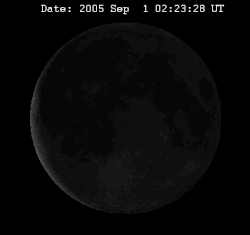Lunar pole
The north and south poles of the moon are the endpoints of the rotation axis of the earth's satellite and have a selenographic latitude of + 90 ° and −90 °, respectively.

From the earth they do not appear exactly at the edge of the lunar figure, but due to a periodic directional fluctuation (" libration in width") each at a very flat angle of a maximum of 6.7 °. The area around the South Pole is much more mountainous than that of the North Pole and is the center of an extensive, crater -strewn highland. The crater edges and heights at both poles of the moon are almost always in the sunlight , which is why they were called mountains of eternal light by earlier selenographers (lunar researchers) such as Hieronymus Schröter and Mädler .
The reason for this phenomenon is that the axis of rotation of the moon - unlike that of the earth - is almost perpendicular to its orbital plane. Also towards the poles of the ecliptic it is only inclined about 1.5 ° (with the earth's rotation it is 23.4 °), so that the elevations near the lunar poles are always touched by sunlight.
Another peculiarity of the moon is its bound rotation : it always assigns almost the same side to the earth because its period of rotation coincides with the period of revolution ( length of the month ). As early as the 19th century, it was assumed that the center of mass of the moon did not coincide with the center of the figure (center of the moon ball). This hypothesis has been confirmed by various lunar probes : the two points are almost 2 km apart, which had to be taken into account in the more recent definition of the selenographic coordinates .
Large structures in the polar regions
The polar lunar landscapes appear strongly distorted due to the flat viewing angle, but this makes the heights all the more clear. With medium-sized telescopes (from about the eight-inch) individual crater rim or mountain peaks can be seen.
The largest craters around the North Pole are Peary , Nansen , Byrd and Hermite (between them the Leibniz Mountains ) and on the back of the moon Rozhdestvenskiy .
The largest ring mountains in the south pole area are Moretus , Newton, Manzinus and Scott , as well as Amundsen and Drygalski near the visual limit and on the back the huge ring structures Schrödinger and Zeeman .
Lunar probes, water ice and planned observatory
In these regions, whose average temperature is likely to be around −50 ° C, US astronomers planned in 2002 to build an observatory that would not be disturbed by terrestrial stray light and radio traffic in about 15 years . It would be cheapest at the edge of the back of the moon, but then the telemetry would have to be done via artificial moon satellites (orbiters).
The valleys between the "Mountains of Eternal Light" are constantly in shadow, which would also offer interesting information and temperature studies. In addition, the Clementine lunar probe was able to detect small amounts of water ice using radar for the first time in 1996 , which was confirmed in 1999 by spectrometer measurements by the Lunar Prospector . About 1% of the ice in the regolith is likely to be added to the lunar surface, but it could also form small ice lenses from a depth of 40 cm. Both possibilities would be of great interest for space travel .
See also
literature
- Bruce A. Campbell, et al .: Radar imaging of the lunar poles. Nature 426, 137-138, November 13, 2003, doi : 10.1038 / 426137a
- JL Margot, et al .: Topography of the Lunar Poles from Radar Interferometry. Science 4 June 1999, Vol. 284. no. 5420, pp. 1658-1660, doi : 10.1126 / science.284.5420.1658
- Paul D. Spudis: The Poles of the Moon and Their Significance Lunar and Planetary Institute 2008 (PDF, 2.83MB, 22 pages. Accessed December 16, 2009)
Web links
- Map of the Moon North Pole (SMART-1)
- Water ice on the lunar poles
- http://www.mondatlas.de/mondnews.html
- Smart-1: near-pole Plaskett crater
- Permanent lighting at the lunar north pole
- Shadows at the South Pole of the Moon - Astronomy Picture of the Day from April 23, 2011.
- LPOD Photo Gallery
Individual evidence
- ↑ Harald Zaun: Dark Side of the Moon. heise.de, January 12, 2002, accessed January 4, 2018 .
